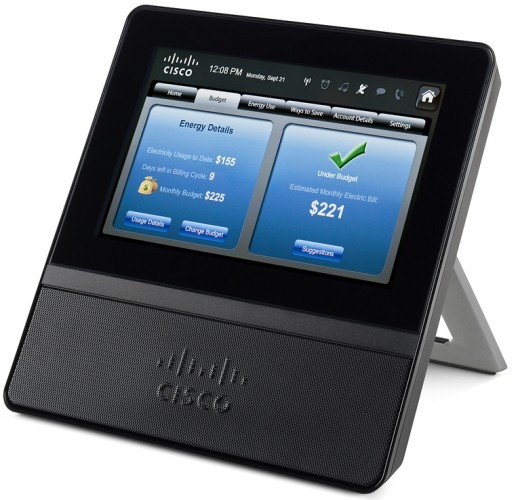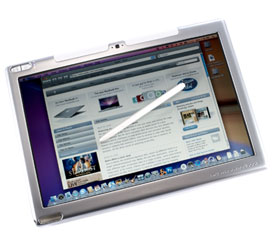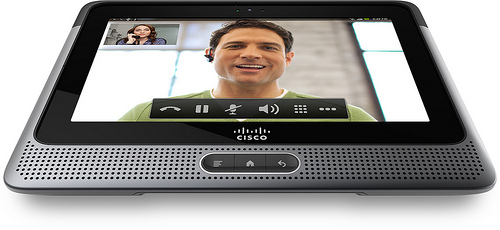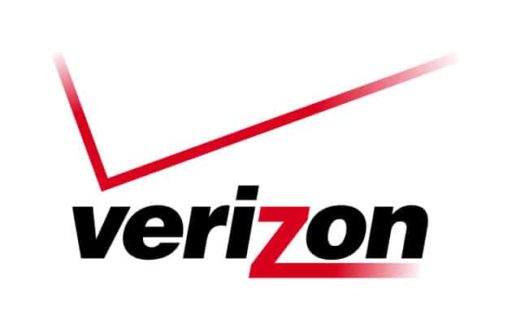Cisco Cius is an Android-based tablet designed for full telepresence interoperability, HD video streaming and real-time video, multi-party conferencing, email, messaging, browsing, and the ability to produce, edit and share content stored locally or centrally in the cloud….
Looks like the Android-toting Cius wasn’t the only tablet out of Cisco this week — the company’s also announced a countertop unit for home energy management with a 7-inch, 800 x 480 capacitive touch screen. Running Ubuntu Linux for MID on a 1.1GHz Intel Atom chip, the Home Energy Controller connects to smart thermostats and appliances over 802.11n WiFi or gigabit ethernet using protocols including ZigBee.
The ultra-portable Cius – which weighs in at just 1.15lbs – supports telepresence interoperability, HD video, multi-party conferencing, email, messaging, browsing and seamless access to the Cloud.
The Cius is also expected to offer a host of new options for corporate users, while allowing businesses to “tap into” the growing Android market.
Through virtual desktop integration, the Cius [provides] flexible computing options with Cloud-based services that [offer] a compelling alternative to today’s PC-on-every-desktop paradigm,” Cisco explained in an official statement.
The device also comes with advanced communication capabilities that work with Cisco’s unified communications and collaboration tools. It can quickly establish instant-message sessions, voice calls and videoconferencing sessions. The device is interoperable with Cisco’s TelePresence videoconferencing system and works with Cisco applications including Cisco Quad, Cisco Show and WebEx tools.
On campuses, the tablet can be docked into the HD Soundstation, which provides wired networking connectivity for a full desktop experience, according to Cisco’s Web site. The docking station will also be able to display high-definition content from the tablet on a connected monitor. Users will also be able to connect USB or Bluetooth keyboards and mice to the docking station for a traditional desktop experience.
Cius is based on Google’s Android operating system, companies deploying the device can look forward to a large pool of developers and many applications that can enhance the device. Puorro said that Cisco chose to base the device on Android “to capture the very large growing developer market” and to avoid reliance on a proprietary operating system, something that has hindered Cisco in the past.
One of my earliest criticisms of the iPad was that it was trying to be everything to everyone. Had it been pitched as a consumer entertainment device with tools for video, photos, music, books and so on, I probably would have liked it more. But I remember being less than impressed when Steve Jobs sat down at the iPad’s debut and demonstrated how to hammer out an email and work on a spreadsheet.
It then lets you keep tabs on your electricity usage, and suggests ways you could improve — assuming you’re using the tablet for its intended purpose instead of watching hardware-accelerated videos on Mediafly, browsing the included app store, or (potentially) using it as a phone of some sort. Forbes reports the device will run $900 per installation, though it’s more likely it’ll arrive subsidized by a monthly power bill. See it in action right after the break, and hit up that PDF at the more coverage link for a full spec sheet.
Additional specs include:
1.Front-mounted 720p HD camera with a 30 frame per second refresh rate.
2.5-megapixel rear facing camera that streams VGA quality video and capturing still images.
3.Dual noise-canceling microphones for audio conferencing.
4.Seven inch, high-resolution widescreen super VGA touch-target display.
5.Single-button TelePresence interoperability that can be utilized either when the tablet is docked, or remotely via Wi-Fi.
On-board accelerometer.
6.802.11 a/b/g/n Wi-Fi and 4G.
7.Bluetooth/Micro-USB.
8.Detachable and serviceable 8-hour battery.
Resources :tgdaily.com,engadget.com





